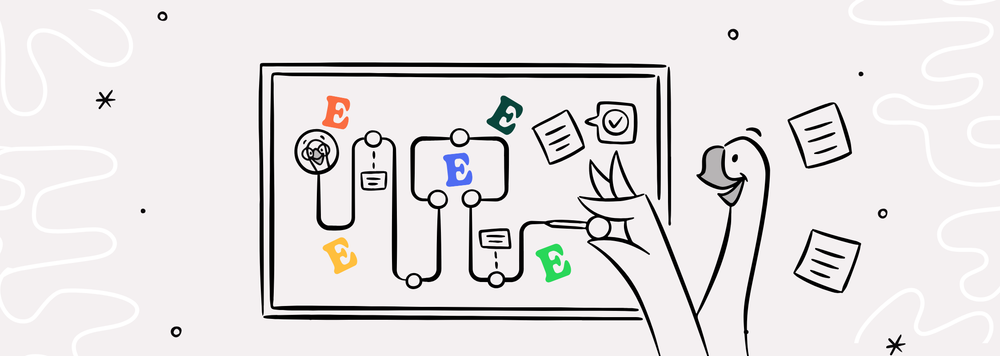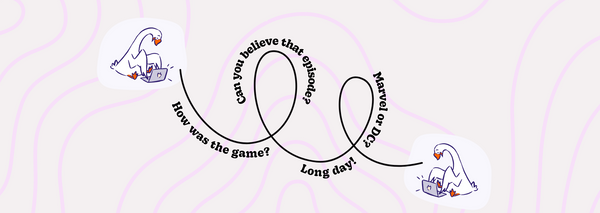Solving Any Business Problem (or at least getting really close) with the 5 E's Framework
This problem-solving framework is ideal for team workshops, leadership retreats, innovation sprints, or even solo reflection when you're stuck.
You know those problems at work that never quite get solved? The ones that get tossed into a retro, parked in a doc called “Opportunities for Improvement,” or just endlessly bounced around in meetings?
We’ve been there too. And it got us thinking — how can we help teams dig deeper into challenges before getting stuck in loop after loop of testing solutions?
That’s when we revisited Andrew’s brilliant breakdown of the 5 E’s of interactive experiences:
- Examination
- Exploration
- Explanation
- Extension
- Externalization.
Originally conceived to help guide creators in making more meaningful and memorable learning moments, Andrew’s framework captured something powerful: a flexible, human-first way to guide people through engagement and discovery.
And the more we looked at it, the more we realized:
💡 This could work just as well in the workplace.
5 Ways to Unpack Business Problems
What Are the 5 E’s?
While the original 5 E’s were designed for Goosechase creators, they translate seamlessly to team-based problem-solving. Think of them as a structured-but-not-stuffy way to unpack sticky workplace issues, surface new insights, and move forward with intention.
Here’s how the 5 E’s apply in a workplace setting:
1. Examination – What do we know, and what do we think we know?
Start by gathering the facts (aka data). Then by surfacing assumptions. Before solving the problem, make sure you’re solving the right one.
2. Exploration – What else might be going on?
This initially referred to physical exploration, but hey, it works in this case, too. Ask the "what ifs". Explore different perspectives, shadow users, and gather stories from across the organization. Don’t jump to solutions. Widen your lens first.
3. Explanation – What are we learning?
Bring together what you’ve discovered. Identify key patterns or barriers. Use this phase to align the team around the core issue and insights.
4. Extension – How might we act on this?
Test a new idea, pilot a process tweak, or try a low-stakes experiment. The goal is to apply what you’ve learned in a way that creates measurable change, good or bad, however small – it will help isolate and confirm that you're impacting the numbers you intend to.
5. Externalization – What will we carry forward?
This social component is what makes learnings extra sticky! Share your learnings, celebrate what worked (or didn’t), and document next steps. By expressing what you’ve learned, you make it more visible, scalable, and invite others to contribute to the process.
The Difference Between Design Thinking, Agile/Scrum, and the 5 E's
While the 5 E’s share DNA with other innovation frameworks, they stand apart in a few key ways:
| Framework | Focus | Strength | Limitation |
|---|---|---|---|
| Design Thinking | Customer empathy → product | Deep discovery and prototyping | Can feel too big or academic for small, scrappy teams |
| Agile/Scrum | Iterative product dev | Efficient execution | Assumes the problem is well-defined |
| 5 E’s | Understanding the problem deeply | Flexible, people-centered, easy to remember | Less explicitly used in business settings (until now!) |
Where Design Thinking starts with users, and Agile starts with features, the 5 E’s start with curiosity — what are we trying to understand better?
That makes it especially powerful for:
- Team dynamics and culture
- Process improvement
- Strategic clarity
- Internal innovation
How to Use This Problem-Solving Framework at Work
Team Collaboration Challenges
The Problem: A team is siloed, communication feels strained, and projects stall at handoff points.
5 E’s in Action:
- Examination: What’s our current workflow? Where are the pain points?
- Exploration: Shadow another team for a day. Interview peers. Collect examples of breakdowns.
- Explanation: Share findings. "It’s not just tools; it’s timing and unclear ownership."
- Extension: Pilot a new cross-functional standup or shared task board.
- Externalization: Reflect on what changed, and propose how it becomes the new norm.
New Product Rollout
The Problem: A new feature launches, but adoption is lower than expected.
5 E’s in Action:
- Examination: What has usage of the new feature been? What do we think is blocking adoption?
- Exploration: Watch users interact with it. Talk to support and sales teams. Gather feedback.
- Explanation: “It’s not the feature, it’s that users don’t know it’s there.”
- Extension: Try a tooltip, in-app guide, or launch campaign. Monitor usage.
- Externalization: Share adoption results and lessons learned with the broader team.
Strategic Planning
The Problem: The org is juggling too many priorities and losing momentum.
5 E’s in Action:
- Examination: What metrics are we watching, and why? What are we focused on right now? Why?
- Exploration: Survey the team on bandwidth, review OKRs.
- Explanation: Synthesize: “We’re trying to do too much without clear criteria.”
- Extension: Test a decision-making framework for project prioritization.
- Externalization: Present what worked (and what didn’t) to shape next quarter's roadmap.
Why Should You Try the 5 E's Framework For Your Business?
Why This Works
The 5 E’s Framework is simple enough to remember, but powerful enough to uncover complexity. It centers people, reflection, and iteration — not just output. It’s a thinking tool, not a checklist — and that flexibility makes it ideal for today’s fast-moving, people-powered teams.
When Andrew first introduced the 5 E's, they were the common thread behind great interactive experiences. Whether in a classroom, scavenger hunt, or training session, those experiences all help people connect, reflect, and grow.
This workplace adaptation is just one way of carrying that idea forward, using the same thoughtfulness, curiosity, and structure to help teams untangle sticky challenges and move toward solutions that stick.
Because whether you’re designing a lesson, a product, or a better way of working together, the goal is the same: Help people engage meaningfully and move forward with purpose.
What is Goosechase?
At Goosechase, experience is everything. Originally inspired by scavenger hunts, Goosechase is an online platform that enables organizations and schools to engage, activate, and educate their communities through delightful interactive experiences. Sign up and try creating a free recreational Experience, or check out our Pricing!





